Struggling with messed-up text or odd symbols when opening documents in Microsoft Word? You're likely encountering file conversion encoding issues. Thankfully, solving this problem doesn't require advanced technical skills. In this guide, we'll walk you through simple steps to fix file conversion encoding problems in Word.
By following the steps outlined in this article, you'll learn how to fix file conversion encoding on Microsoft Word for a seamless file-handling experience.
Part 1: Understanding File Conversion Encoding in Microsoft Word
Before we proceed toward solutions, it's essential to understand what file conversion word encoding means and how it affects your documents. Encoding is the process of converting characters and symbols into a binary format that computers can understand and process.
Different encoding standards, such as ASCII, Unicode, UTF-8, and UTF-16, exist to represent text in different languages and character sets.
Microsoft Word supports various encoding formats, but sometimes, when a document is created or saved using one encoding format and then opened or shared with another system that uses a different encoding format, the file conversion microsoft word encoding problem can occur. This mismatch in encoding can lead to missing characters, or incorrect display of special characters, making the document difficult or impossible to read and edit.
Part 2: How to Fix File Conversion Encoding on Microsoft Word?
Now that you understand what is "file conversion encoding in Microsoft Word", let's explore various solutions to resolve this issue.
Fix 1: Use Wondershare Repairit to Resolve Encoding Errors

Wondershare Repairit - Word File Repair
1,010,994 people have downloaded it.
-
Repair damaged files with all levels of corruption, including blank files, files not opening, unrecognizable format, unreadable content, files layout changed, etc.
-
Perfectly repair corrupted word .docx files without modifying the original file.
-
Provide an easy fix option for text, images, font, hyperlinks, header, footer, etc.
-
Support Office 365, MS Word 2019, 2016, 2013, 2010, 2007, and earlier versions.
-
Support Windows 11/10/8/7/Vista, Windows Server 2003/2008/2012/2016/2019/2022, and macOS 10.10~macOS 14.
-
Except Word, Repairit also supports all formats of PDF, Excel, PowerPoint, PDF, ZIP, and Adobe files.
Wondershare Repairit is a handy tool built to fix corrupted Word documents, even those with encoding problems. It scans your files, identifies encoding issues, and tries to fix them automatically, saving you time and effort. With its user-friendly interface, repairing your documents becomes hassle-free.
Here's how to use Wondershare Repairit:
Step 1: Launch Wondershare Repairit on your device. Here you will see various options such as Photo Repair, Audio Repair, and so on. Select the "File Repair" option to fix the Word file.
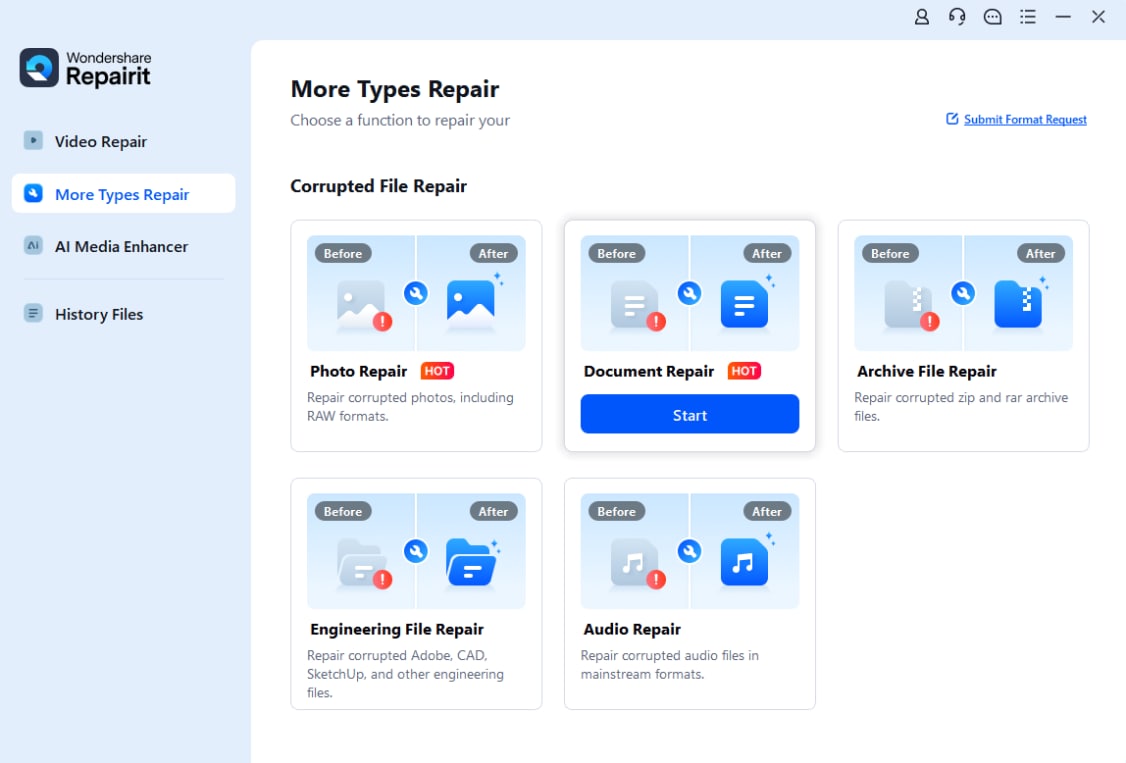
Step 2: Click "Add+” and navigate to the problematic Word document.
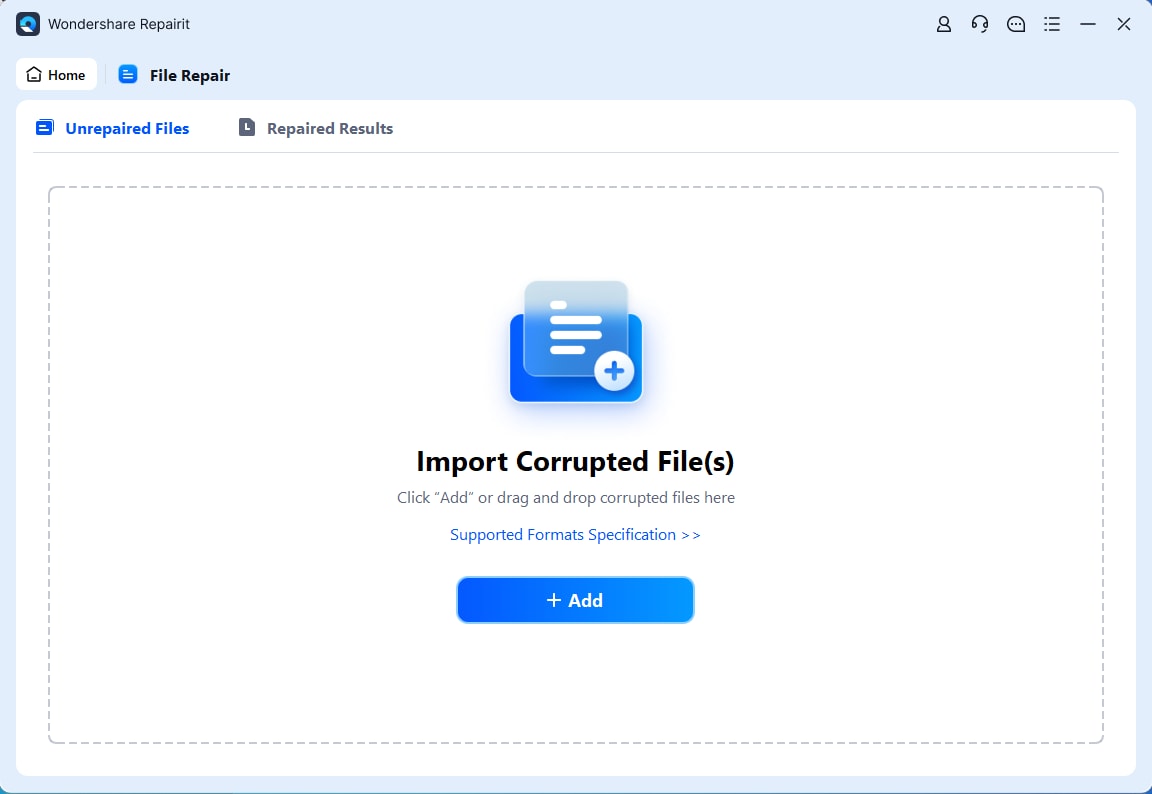
Step 3: Once the document is added, click "Repair" to initiate the repair process. Wondershare Repairit will scan the document and attempt to fix any encoding issues or other problems.
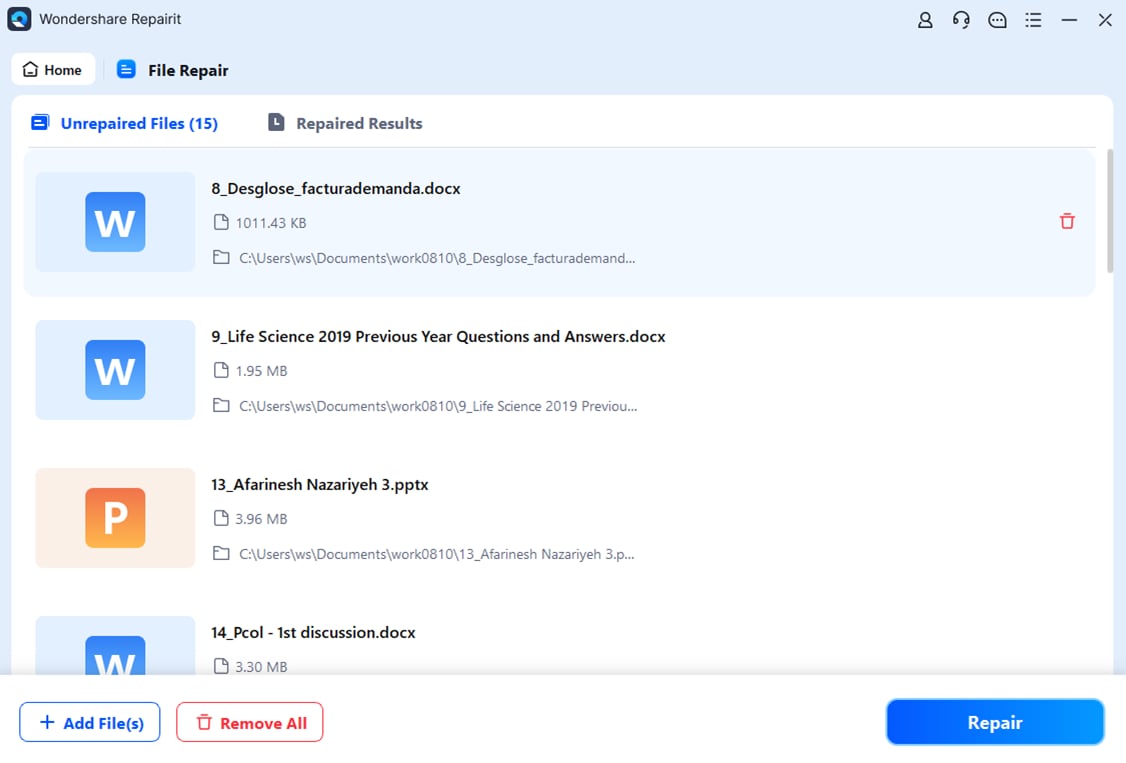
Step 4: After the repair process is complete, you can preview the repaired document and then hit “Save” to save the fixed Word file to a new location.
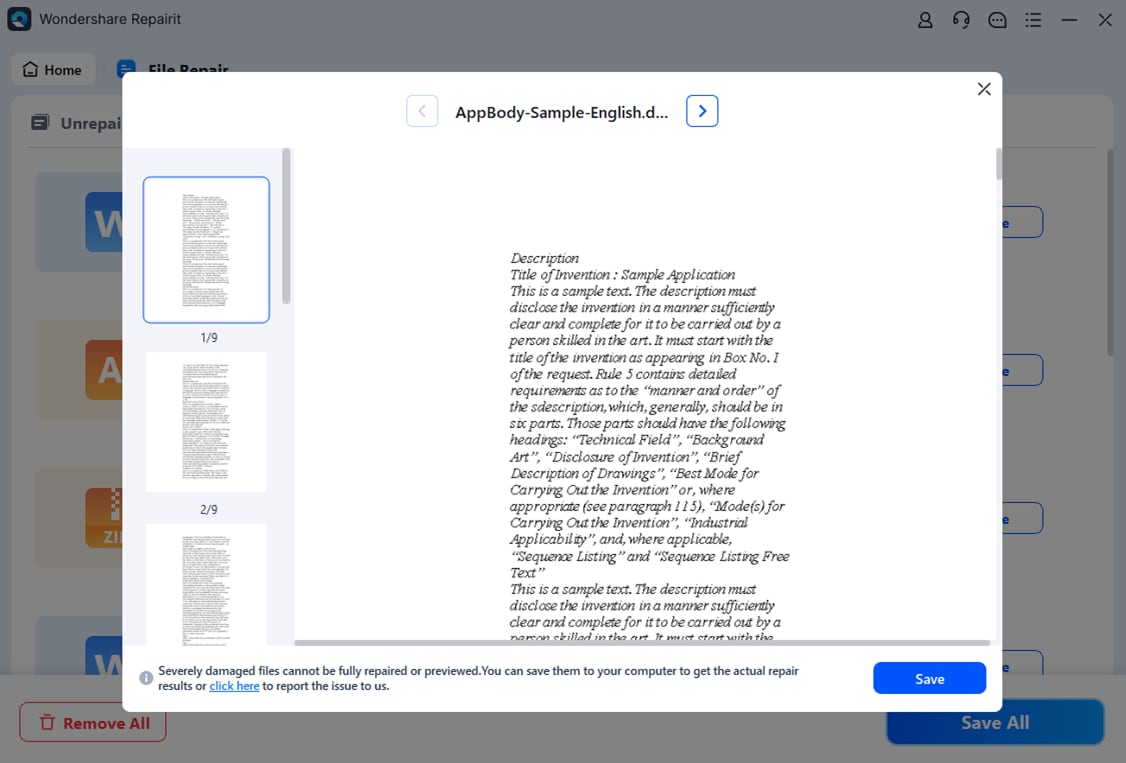
Fix File Conversion Encoding on Microsoft Word Now

More Related Articles
Fix 2: Try Opening the Word File in Different Software
Sometimes, the file conversion encoding microsoft word issue may be specific to a particular software or version of Microsoft Word. In such cases, you can try opening the problematic document in a different software program that supports the encoding format used in the document.
You can try opening Word in Google Docs. It is a web-based word processor that can open and edit Word documents. It automatically handles encoding conversions, so it may be able to display the document correctly, even if Word is struggling with the encoding.
By opening the problematic document in different software programs, you may be able to bypass the file conversion word encoding issue and access the document's content.
Fix 3: Use the "Save As" Feature
Microsoft Word's "Save As" feature can be a simple yet effective solution for resolving encoding issues. This method involves saving the problematic document in a different encoding format, which may help resolve the "file conversion in word encoded text" error.
Here's how to do it:
Step 1: Open the troublesome Word document. Click "File" at the top left, then choose "Save As" from the menu on the left.
Step 2: In the "Save As" box, pick where to save the new document version. Then, click "Tools" and choose "Web Options".

Step 3: In the "Web Options" box, go to "Encoding" and choose a new format from the menu. Options like "Unicode (UTF-8)," "Unicode (UTF-16)," or "Unicode (UTF-16 Little Endian)" are common.

Step 4: Click "OK" to apply the new encoding format. Save the document with a new name or in a different location.
By saving the document with a different encoding format, you may be able to resolve the "file conversion microsoft word encoding problem" and ensure that the text displays correctly.
Fix 4: Update Microsoft Word
In some cases, the "file conversion encoding microsoft word" issue may be caused by a bug or compatibility problem with an outdated version of Microsoft Word. Updating to the latest version of Word can potentially resolve encoding issues and improve compatibility with various document formats and encoding standards. Here's how to update Microsoft Word:
Step 1: Click on the "File" menu and select "Account". Under the "Product Information" section, click on Update Options> Update Now.

Step 2: Word will check for available updates. If an update is available, follow the on-screen instructions to download and install the latest version.
Keeping Microsoft Word up-to-date can help ensure that you have access to the latest bug fixes, performance improvements, and compatibility enhancements, which may resolve encoding issues and improve overall document handling.
Fix 5: Check for Corrupted Fonts
Corrupted or missing font files can sometimes cause encoding issues and garbled text in Word documents. To resolve this problem, you can try reinstalling or repairing the font files on your system. Here's how:
Step 1: Open the Control Panel on your Windows computer and click on "Fonts."
Step 2: In the Fonts window, you have two options:
- Repair: Some operating systems offer a repair option for fonts. Right-click on the problematic font and see if there's a repair option available. Follow the prompts to repair the font file.
- Reinstall: If repairing doesn't work, you may need to reinstall the font. To do so, head to Settings> Personalization> Fonts. Select the “Get More Fonts in Microsoft Store”.

Step 3: After reinstalling or repairing the font files, try opening the problematic Word document again.
Fix 6: Consult Microsoft Support
If none of the above solutions work, and you're still encountering the "file conversion in word encoded text" error, it may be time to seek assistance from Microsoft Support. Microsoft provides various support channels, including online forums, knowledgebase articles, and customer support representatives.
Step 1: Visit the Microsoft Support website and search for "file conversion encoding microsoft word" or a similar keyword related to your issue.

Step 2: Look through the knowledgebase articles and forum discussions for any relevant solutions or tips.
Step 3: If you can't find a solution, use the “Need More Help” box to explain your problem. Include details about the issue, your Word version, and any steps you've tried to fix it.

Microsoft Support can provide personalized assistance and may offer additional solutions or workarounds specific to your situation.
Part 3: What Triggers the "File Conversion in Word Encoded Text" Error?
Several factors can contribute to the file conversion in word encoded text error, including:
- Incompatible character encoding: If a document is made or saved in one encoding format and then opened on a system with another format, the text might look messed up or wrong.
- Corrupt font files: If the font files on your computer are damaged or missing, Word documents may not show text correctly, leading to messed-up text.
- Software compatibility issues: Using different versions of Microsoft Word or other software to open or edit a document can cause encoding errors.
- File corruption: In some cases, the file itself may be corrupted, causing Word to misinterpret the encoding or display the text incorrectly.
Part 4: Tips to Avoid File Conversion in Word Encoded Text
While these tips can fix encoding problems in documents, it's best to prevent these issues from happening at all. Here are some tips to help avoid "file conversion in word encoded text" errors:
- Use consistent encoding formats: Try to use the same encoding, like Unicode (UTF-8 or UTF-16), for all your Word documents. It's widely supported and works with many languages and characters.
- Save documents in compatible formats: When sharing Word documents, save them in a format the recipient can open, like .docx, .pdf, or .rtf, to ensure compatibility with their software and system.
- Embed fonts: If your document uses special fonts, embed these fonts in the document. This makes sure it looks right, even if the recipient doesn't have those fonts.
- Use plain text formats for compatibility: If you need to share text-based content with others and compatibility is a concern, consider saving or exporting the document as a plain text file (.txt) or using a markup language like Markdown or HTML.
- Keep software and operating systems updated: Keeping your software, like Microsoft Word and your operating system, up to date can fix bugs and ensure it works well with the newest encoding standards.
By following these tips, you can minimize the likelihood of encountering "file conversion in word encoded text" errors and improve the overall compatibility and reliability of your Word documents.
Conclusion
Getting stuck with the file conversion encoding microsoft word issues can be frustrating, but with the right solutions and preventive measures, you can overcome these challenges and ensure the integrity of your Word documents.
-
Q1: Why does the "file conversion in word encoded text" error occur?
-
The "file conversion in word encoded text" error can occur due to various reasons, such as incompatible character encoding formats, corrupt font files, software compatibility issues, or file corruption.
-
Q2: Can I prevent encoding issues in Word documents?
-
Yes, to prevent encoding issues, use the same encoding (like Unicode), save documents in formats others can open, embed fonts, use plain text for better compatibility, and keep your software and systems updated.
-
Q3: Is there a way to fix encoding issues without third-party software?
-
Yes, you can try various built-in solutions in Microsoft Word, such as using the "Save As" feature to save the document with a different encoding format, updating Word to the latest version, or reinstalling/repairing font files.
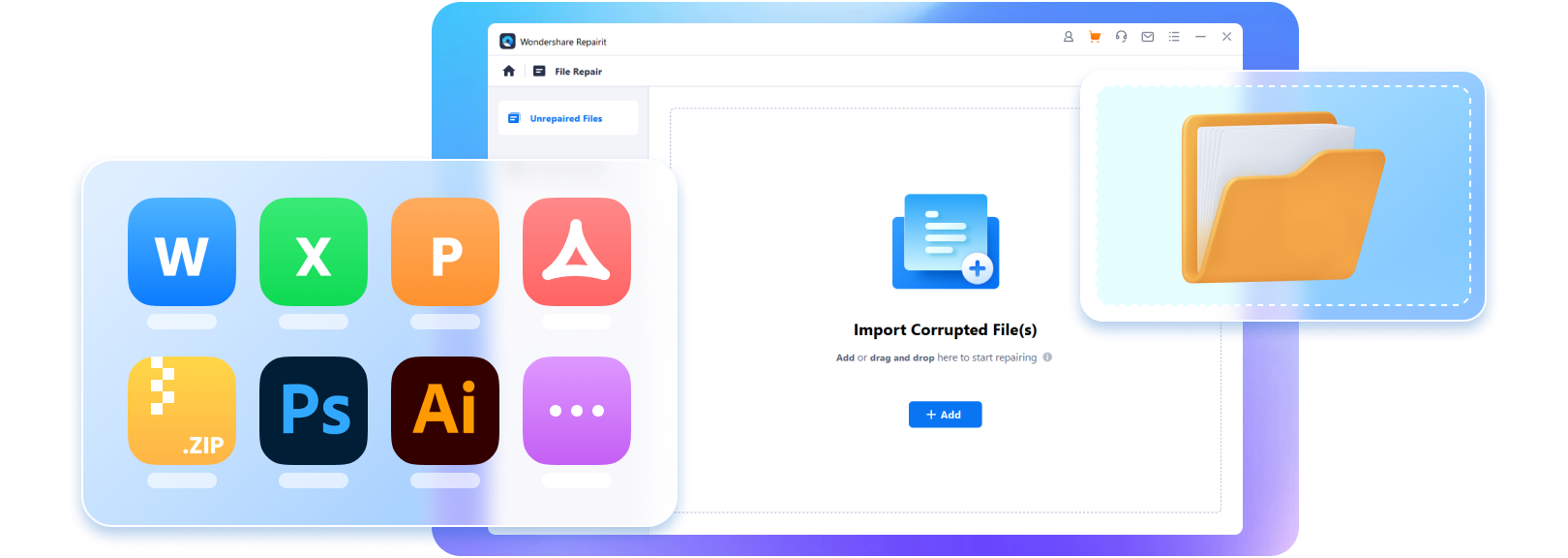


 ChatGPT
ChatGPT
 Perplexity
Perplexity
 Google AI Mode
Google AI Mode
 Grok
Grok
